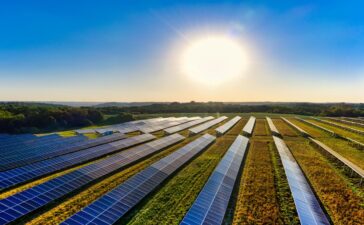Natural resources are a divine endowment, with each element possessing unique significance and their existence being crucial for human survival. However, recently, the primary natural resources—water, energy, and food—have encountered escalating challenges and pressures that jeopardize their sustainability. The existence of climate change, population growth, and urbanization undermines the sustainability and accessibility of these resources. The identified risks have led to the development of the Nexus concept, illustrating the sophisticated interdependence among water, food, and energy. This approach also increases the cooperative management of resources to ensure the presence of systems that guarantee the security and stability of natural resources. This article will describe the foundational concept of the Nexus Approach, along with its main principles and the drivers of the nexus approach, All while underscoring the necessity of integrating between the modern technologies such as AI and Machine learning with the Data collection methods to develop adaptive strategies that secures the Water, Food, and Energy Resources
Global Resource Challenges: Water, Energy, and Food
The most significant factors that exert increasing pressure on countries worldwide are natural resources. The availability of natural resources, which includes energy, food, and water, is influenced by a variety of factors, including population growth, climate change, and municipal expansion. These factors have resulted in the development of insecure energy markets, food production instability, and water scarcity and shortages. These concerns are interconnected and have an impact on the social, economic, and environmental conditions.
Water Scarcity
Life depends on water, which has an impact on all aspects of life. It clearly affects agriculture, industry, and the environment as a whole. Despite its significance, most nations now face water scarcity as one of their major problems.

- According to the World Wildlife Fund, 2.7 billion people struggle to obtain water at least once a month.
The challenge has evolved into not only a scarcity of water but also the accessibility of safe and clean water sources, which poses a significant global issue due to the potential health and safety risks associated with contaminated water sources.
- According to the World Wildlife Fund, 1.1 billion people lack reliable access to water. In areas with inadequate sanitation, cholera claims over 2 million lives annually, predominantly among children.
- According to the WHO & UNICEF, In 2022, 3.5 billion people still lacked safely managed sanitation, including 419 million who practiced open defecation.
One of the factors that strongly affects the availability of water resources is climate change, generating a cycle of unpredictability in weather, which leads to sudden shifts in weather patterns. As a result, several regions experience unanticipated droughts, and others witness sudden floods.
- According to the World Meteorological Organization, climate change has exacerbated water issues by causing extreme weather events, such as severe floods in East Asia and altered water availability due to rising temperatures and sea levels.
These findings highlight the significant concerns of water scarcity and indicate the interconnected issues in the energy and food sectors
Energy dilemma
The energy industry is not immune to global resource challenges. In today’s technological era, energy is essential for human life, powering transportation, water treatment facilities, factories, and other infrastructures. Fossil fuels such as natural gas and oil have significantly impacted the economic development of today’s societies; however, with the growing importance of renewable energy, it is now recognized that solar, wind, and hydroelectric power will serve as the principal energy sources of the future. The growing dependence on fossil fuels has resulted in significant environmental deterioration, with greenhouse gas emissions and air pollution being the primary drivers of global warming and climate change.
- According to the IPCC, the energy industry is the largest contributor to greenhouse gas (GHG) emissions worldwide.
- According to the IEA, The prolonged conflict between Russia and Ukraine has caused natural gas and oil prices to rise significantly, which has hurt developing nations and European nations that depend on Russian natural gas exports by creating instability in the flow of natural gas within their borders.
After prices skyrocketed, it became evident that fossil fuels may trigger a worldwide crisis that would impact nations’ industries, transportation systems, and business operations. The interrelated issues of fossil fuel dependency, the shift to renewable energy, and water scarcity are undermining agricultural output, necessitating a more detailed analysis of food insecurity.

Food Insecurity
Food has become extremely vulnerable due to the depletion of resources like energy and water. The reasons for this include the fact that COVID-19 was a shock to the world, as the UN predicted that 691 and 783 million people worldwide would experience severe food insecurity in 2022 (FAO, 2023), but the Russian-Ukrainian war was also a major factor in the crisis’s continuation due to supply chain disruptions that raised food prices. and climate change is also one of the primary causes of the global food crisis; according to World Bank estimates, 80% of the world’s population lives in Sub-Saharan Africa, South Asia, and Southeast Asia, where they face the threat of crop failures and hunger due to climate change (World Bank group, 2022).
Defining The Nexus Approach
The Nexus approach was born out of the 2011 Bonn Conference, which aimed to find solutions to ensure water, energy, and food security. “The Bonn 2011 Conference: The Water, Energy and Food Security Nexus – Solutions for the Green Economy, is frequently regarded as the starting point of the nexus concept” (Schlör, Märker, and Venghaus, 2020). The essential meaning of the Nexus approach was clarified by Schwärzel, Hülsmann, and Ardakanian in a white paper published by the United Nations University. They stated that the approach is founded on the knowledge that environmental resources are inextricably linked; taking into account their mutual dependencies in management may, therefore, increase overall efficiency in resource use and ensure the equitable sharing of benefits. Moreover, the key idea of a nexus strategy is to minimize resource consumption, recover resources, and reuse resources (Schwärzel, Hülsmann, & Ardakanian, 2014). The nexus examines the process of understanding resource interdependence by explaining how much water is required for agriculture and energy production, while also highlighting the ways in which the energy sector helps deliver and distribute water to residential areas. As a result, the nexus method offers a model that clarifies this dependency and explains how it helps to effectively manage trade-offs and create synergies. Consequently, the nexus approach distinguishes from traditional standalone methodologies in a significant dimension.
Key Principles
The Nexus approach’s key principles constitute a building block to a sophisticated framework for handling the world’s resource management concerns. It also shows an integrated framework that perceives the difficulties in a comprehensive way rather than a fragmented form. These principles help to turn this technique into an effective one. This article will describe two of the Nexus approach’s main principles: systems thinking and governance
Systems Thinking
Systems thinking is one of the pillars of the Nexus approach as it shifts the focus from the disparate to the interconnected, and according to Donella Meadows, “a system isn’t just any old collection of things. a system is an interconnected set of elements that is coherently organized” (Meadows, 2008). Based on Meadows’ concept of the system, Holger Schlör, Carolin Märker, and Sandra Venghaus explained that systems thinking includes four categories(Schlör, Märker & Venghaus, 2021). Elements, which Meadows described as players, a coach, and a football field. The presence of elements within the system is essential, but these elements can change according to the requirements of the system. Secondly, the interconnections, which are the relationships between the elements, as water (an element) is relied upon in agriculture. Thirdly, the purpose, which is the basic goal of the systematic process, in the case of the nexus, water, food and energy, the goal of this is ultimately sustainability. Finally, the behavior over time, which is the knowledge of the work that may require the work of transforming the goals and elements of the system, in addition to adapting to what may happen over time, such as changing the production process of food with the presence of climate changes.
Additionally, because resource isolation can have unintended consequences, systems thinking supports the integrated approach of managing resources collectively rather than separately. Although biofuel manufacturing generates energy, it also uses a lot of water, which might eventually have an impact on agriculture. To guarantee that the three resources—food, energy, and water—are handled effectively and without endangering one another, the Nexus method can make the right choices by weighing trade-offs and fostering synergies.
Governance
One of the most crucial tenets of the Nexus approach is governance, as resource management is often surrounded by complexity, change, and ambiguity, necessitating the existence of a governance structure that responds to emerging issues like economic crises, climate change and attempts to coordinate relations between various sectors. The Nexus approach has contributed to the development of governance methods by substituting government decision-making methods for decisions related to specific sectors with those linked to the entire system. In this situation, multi-level governance is required to accommodate both local and global regulations, and the Nexus model’s complementary approach offers an in-depth understanding of all parties involved, including governments, corporations, farmers and other scopes. In this manner, the system-benefitting policies flow together to create a sustainable environment that fosters genuine collaboration across the agricultural, energy, and water sectors. The Nexus approach performs duties in this way.
These principles play a part in achieving the Nexus approach’s successful outcomes. This means that the Nexus approach has the potential to achieve some of the SDGs, particularly “Goal 2. End hunger, achieve food security and improved nutrition and promote sustainable agriculture, Goal 6. Ensure availability and sustainable management of water and sanitation for all, Goal 7. Ensure access to affordable, reliable, sustainable and modern energy for all.” (Page 18, United Nations, 2015)
Drivers and Data Challenges
Population growth is a major driver of the Nexus approach, putting huge strain on natural resources and the infrastructure that controls and administers them. The SDG Knowledge Hub reports that “the global population is expected to grow dramatically, reaching 9.9 billion by 2050, putting enormous pressure on resource consumption.” However, the Nexus approach is driven by more than just population growth. Poor living circumstances in rural regions push individuals to seek economic stability, resulting in urbanization. According to Hoff (2011), about half of the world’s population lives in cities, and with approximately 800,000 new urban residents arriving each week, this figure is expected to rise to 70% by 2050, making it difficult for some countries to meet their population needs, whether in terms of water and sanitation, energy efficiency, or food security. It puts pressure on the economy of countries, but population growth and urbanization may be regulated through developing concise strategies to improve the infrastructure of natural resources and providing a proper transportation network and roads to prevent causing further problems.

Then comes climate change, which could endanger the existence of agricultural lands, the supply of fresh water resources, and the production of energy. Floods, rising sea levels, and other factors that affect the ease of access to resources make agricultural production extremely difficult because they affect water supplies and lower agricultural yields. As a result, climate adaptation strategies have become a key factor in adapting to climate change in order to prevent resource waste, and it is possible to achieve very satisfactory results if they are integrated with the Nexus approach’s goals and vision.
Data is recognized as one of the most crucial pillars for maintaining the progress of any development project or aim, and it is strongly related to the Nexus approach since it indicates how the water, energy, and food sectors interact. Continuous data collection analyzes the effectiveness of policies that examine the Nexus’s success, and finally develops a shared environment between sectors by monitoring one sector’s progress and the influence of that progress on the other sectors. However, the Nexus method has data gaps. “The combined domains of water and energy, at least at the spatial scales we address above, are poorly covered by the data sources that are currently available for analyses of the water-energy nexus”(Larsen et al., 2019). This includes a shortage of precise data sets documenting, for example, the water usage by the energy sector in a spatiotemporal resolution suitable for linking between water resource and energy system models. The efficiency and quality of the available data are insufficient to ensure the success of the Nexus approach in monitoring the water, energy, and food sectors together, which could end up in return to the governance of these sectors in an isolated approach.
The proposed solution here is to combine the data collection process with advanced technology (artificial intelligence and machine learning). The presence of modern technology like the Internet of Things (IoT) and artificial intelligence (AI) helps to analyze data with the diversity of data collection sources, such as remote sensing, geographic information systems (GIS), satellite and weather information-based consultation, real-time monitoring, drones, digital twins, and so on. AI has grown to be an essential tool in developing almost all industries because it has been categorized as one of the strongest tools that can eliminate obstacles and move faster towards a sustainable future. due to the fact that AI assists in discovering feasible and innovative solutions that enhance decision-making processes, which accelerates the achievement of sustainable development goals. “Some academics emphasized how the effective use of datasets across all industries may support the attainment of UN 2030 Agenda targets, guaranteeing consistent energy savings (up to 20%), carbon emissions reduction, water use optimization, and improvements in citizens’ well-being and quality of life.”(Drews et al., 2022). As artificial intelligence and machine learning have advanced, some derivatives have also surfaced. One such example is IBM Pairs Geoscope, a cloud-based service that gathers and analyzes location and time data using satellites, drones, and other means. The found data is paired with hyperspectral pictures in a matter of minutes to aid in the prediction of factors that might impact the energy supply to particular regions. This technology is also capable of benefiting numerous sectors and communities from artificial intelligence studies without the need to evaluate massive data sets, which leads to “Drastically reducing time, cost-effectiveness and high accuracy makes Pairs Geoscope a pioneering technology” (Chaturvedi, 2019)
Conslusion
In summary, the Nexus approach has taught us a very important lesson: the world is now defined by interconnections, and the Nexus approach aims to stop managing resources in isolation and start working on a connected system that links food, energy, and water. Continuing to manage resources in isolation will increase the burden on available resources. According to the key principles of the Nexus approach, systems thinking clarified that the existence of an all-encompassing system that controls resources will mitigate the escalation of the deficiencies of each sector functioning independently. and the ultimate objective of this approach is to guarantee the fair allocation of resources with the presence of policy coherence via the use of suitable governance mechanisms that establish an organizing structure for the Nexus approach, Furthermore, in order to accomplish the overall objective of the Nexus approach, countries should prioritize investing in resilient infrastructure that can withstand greater pressures, improve cross-sector collaboration, and reduce the silos of their policies. This should be in combination with working to integrate data collection and modern technology in order to reduce the challenge of the data gap by using technological methods like IBM Pairs Geoscope to enhance the accuracy and scalability of natural resource management.
References
- Chaturvedi, A. (2019). IBM PAIRS Geoscope – A breakthrough in faster spatial data analytics via multiple datasets. Geospatial World. https://geospatialworld.net/blogs/ibm-pairs-geoscope-data-analytics/
- Drews, M., Larsen, M. A. D., Petrovic, S., Engström, R. E., Liersch, S., Karlsson, K. B., & Howells, M. (2022). Challenges of data availability: Analysing the water-energy nexus in electricity generation. Science of the Total Environment, 26, 866–881. https://www.sciencedirect.com/science/article/pii/S2211467X1930118X
- Food and Agriculture Organization (FAO). (2023). The state of food security and nutrition in the world 2023. https://openknowledge.fao.org/server/api/core/bitstreams/f1ee0c49-04e7-43df-9b83-6820f4f37ca9/content/cc3017en.html
- Hoff, H. (2011). Understanding the nexus: Background paper for the Bonn 2011 Conference—The water, energy and food security nexus. Stockholm Environment Institute. https://www.sei.org/publications/understanding-the-nexus/
- Intergovernmental Panel on Climate Change (IPCC). (2014). Climate change: Implications for the energy sector. https://www.worldenergy.org/assets/images/imported/2014/06/Climate-Change-Implications-for-the-Energy-Sector-Summary-from-IPCC-AR5-2014-Full-report.pdf
- International Energy Agency (IEA). (2024). World energy outlook 2024. https://www.iea.org/reports/world-energy-outlook-2024/executive-summary
- Man, C., Zembilci, E., & Welsh, C. (2020). COVID-19 and food security: What you need to know. Center for Strategic and International Studies (CSIS). https://www.csis.org/programs/global-food-and-water-security-program/archives/covid-19-and-food-security/covid-19-and
- Meadows, D. H. (2008). Thinking in systems: A primer. Chelsea Green Publishing. https://books.google.com.eg/books?hl=en&lr=&id=CpbLAgAAQBAJ
- Schwärzel, K., Hülsmann, S., & Ardakanian, R. (2015). UNU-FLORES: Advancing a nexus approach for the sustainable management of water, soil and waste. United Nations University Institute for Integrated Management of Material Fluxes and of Resources (UNU-FLORES). https://collections.unu.edu/eserv/UNU:2699/Whhitebook_AdvancingNexusApproach.pdf
- SDG Knowledge Hub. (2020). World population to reach 9.9 billion by 2050. https://sdg.iisd.org/news/world-population-to-reach-9-9-billion-by-2050/
- Venghaus, S., Schlör, H., & Märker, C. (2021). Developing a nexus systems thinking test: A qualitative multi- and mixed methods analysis. Renewable and Sustainable Energy Reviews, 138. https://www.sciencedirect.com/science/article/abs/pii/S1364032120308273#bib33
- Williams, A., Kennedy, S., Philipp, F., & Whiteman, G. (2017). Systems thinking: A review of sustainability management research. Journal of Cleaner Production, 148, 866–881. https://www.sciencedirect.com/science/article/abs/pii/S0959652617302068
- World Bank Group. (2022). What you need to know about food security and climate change. https://www.worldbank.org/en/news/feature/2022/10/17/what-you-need-to-know-about-food-security-and-climate-change
- World Meteorological Organization (WMO). (2021). Wake up to the looming water crisis, report warns. https://wmo.int/news/media-centre/wake-looming-water-crisis-report-warns
- World Wildlife Fund (WWF). (2025). Water scarcity overview. https://www.worldwildlife.org/threats/water-scarcity#:~:text=Only%203%25%20of%20the%20world’s,one%20month%20of%20the%20year.
- Yuan, M.-H., & Lo, S.-L. (2022). Principles of food-energy-water nexus governance. Renewable and Sustainable Energy Reviews, 155. https://www.sciencedirect.com/science/article/abs/pii/S1364032121012028
Discover more from Future of Society
Subscribe to get the latest posts sent to your email.





